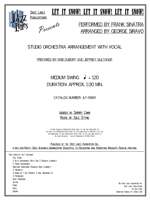LET IT SNOW! LET IT SNOW! LET IT SNOW!
Performed by Frank Sinatra
Arranged by George Siravo, Prepared by Rob DuBoff and Jeffrey Sultanof

Cat #: JLP-9889
$65.00This item usually ships within 1 business day.
Questions?
Please call +1-518-587-1102 or email us.
Edition: Jazz Studio Orchestra Arrangement with Vocal
Description: Swing - Medium Difficult
Publisher: Jazz Lines Publications
It is widely known that from 1943 to 1953 Axel Stordahl was Sinatra’s conductor and arranger. However, what hasn’t been widely understood is the extent to which he had assistance in the creation of arrangements. The concept of ‘ghost writing’ was commonplace at the time. The radio networks and television and movie studios had composers and arrangers on staff whose job it was to produce everything from film scores to incidental background music for announcer-read commercials. These on-staff arrangers were also available to help fill out a program of music needed for an upcoming performance. It’s no secret that as Sinatra became a major star in the 1940s he was performing on a near-daily basis. Due to the number of live dates Sinatra was involved in (concerts, radio, or television) it would have been very difficult for Stordahl to arrange new material to meet the demand. Hence, several ‘ghost writers’ were employed by the Sinatra organization to help quickly produce arrangements of popular songs of the day. Some of the people who contributed arrangements were Billy May, Bill Bunt, Neal Hefti, Earle Hagen, John Hicks, Lowell Martin, and George Siravo. In fact, there are at least two instances of arrangements that were begun by one arranger and finished by another. The two such arrangements are Don’t Fence Me In (Lowell Martin and Billy May) and The Brooklyn Bridge (Bill Bunt and Axel Stordahl). Until now it was widely believed that Stordahl had written most if not all of these arrangements. Now, due to the availability of materials from Sinatra’s library, we are able to determine the actual arrangers of this historic music.
This particular arrangement was written for Sinatra's December 5, 1945 appearance on the Songs by Sinatra radio show, sponsored by Old Gold cigarettes. This radio program ran from September 12, 1945 to April 23, 1947 when it was cancelled as the sponsor, P. Lorillard & Co, the maker of Old Gold cigarettes, did not renew the contract. The original arrangement was later modified to include the B. Swanson vocal group and then officially recorded in 1950. It was released by Columbia as part of the album Christmas Songs by Sinatra.
The arrangement gets off to a brisk start with its ascending introduction, and doesn't really let up much for the rest of the performance. Sinatra handles the melody beginning at melody 5; the horn backgrounds should be a little on the edgy side, but ultimately also maintain a delightful bounciness about them as well. In contrast, the string backgrounds should be fairly genteel and smooth.
A key change at measure 37 marks the beginning of the ensemble shout chorus. The string accompaniment underneath remains quite subtle, but the horns (and the brass in particular) should play with an appropriately firm punchiness. A quick tenor saxophone solo takes over at measure 45, but is ultimately shoved back to the sidelines by the full ensemble six measures later. The saxes and brass perform a couple quick riffs to return things back to the original key at measure 57.
At this point, Sinatra returns with the melody, accompanied by backgrounds that are not identical as before, but should be approached in a similar manner. For the 1945 radio performance there was a cut to the melody's final A section. The entire arrangement has been included here with the cut indicated giving you the option to perform it either way. The last four measures of the arrangement see the band rapidly build toward a brief but effective conclusion.
This publication has been prepared using the original George Siravo pencil score as well as the set of parts used during both the 1945 radio performance and the 1950 studio recording.
Vocal
2 Alto Saxophones
2 Tenor Saxophones
Baritone Saxophone
3 Trumpets
3 Trombones
3 Violins
Viola
Cello
Guitar
Piano
Bass
Drums
Trumpet 1: D6
Trombone 1: Bb4










